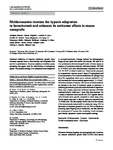Dichloroacetate reverses the hypoxic adaptation to bevacizumab and enhances its antitumor effects in mouse xenografts
| dc.contributor.author | Kumar, K | |
| dc.contributor.author | Wigfield, S | |
| dc.contributor.author | Gee, HE | |
| dc.contributor.author | Devlin, CM | |
| dc.contributor.author | Singleton, D | |
| dc.contributor.author | Li, J-L | |
| dc.contributor.author | Buffa, F | |
| dc.contributor.author | Huffman, M | |
| dc.contributor.author | Sinn, AL | |
| dc.contributor.author | Silver, J | |
| dc.contributor.author | Turley, H | |
| dc.contributor.author | Leek, R | |
| dc.contributor.author | Harris, AL | |
| dc.contributor.author | Ivan, M | |
| dc.date.accessioned | 2017-11-27T15:19:19Z | |
| dc.date.available | 2017-11-27T15:19:19Z | |
| dc.date.issued | 2013-06 | |
| dc.identifier.issn | 0946-2716 | |
| dc.identifier.issn | 1432-1440 | |
| dc.identifier.uri | http://hdl.handle.net/10026.1/10288 | |
| dc.description.abstract |
Inhibition of vascular endothelial growth factor increases response rates to chemotherapy and progression-free survival in glioblastoma. However, resistance invariably occurs, prompting the urgent need for identification of synergizing agents. One possible strategy is to understand tumor adaptation to microenvironmental changes induced by antiangiogenic drugs and test agents that exploit this process. We used an in vivo glioblastoma-derived xenograft model of tumor escape in presence of continuous treatment with bevacizumab. U87-MG or U118-MG cells were subcutaneously implanted into either BALB/c SCID or athymic nude mice. Bevacizumab was given by intraperitoneal injection every 3 days (2.5 mg/kg/dose) and/or dichloroacetate (DCA) was administered by oral gavage twice daily (50 mg/kg/dose) when tumor volumes reached 0.3 cm(3) and continued until tumors reached approximately 1.5-2.0 cm(3). Microarray analysis of resistant U87 tumors revealed coordinated changes at the level of metabolic genes, in particular, a widening gap between glycolysis and mitochondrial respiration. There was a highly significant difference between U87-MG-implanted athymic nude mice 1 week after drug treatment. By 2 weeks of treatment, bevacizumab and DCA together dramatically blocked tumor growth compared to either drug alone. Similar results were seen in athymic nude mice implanted with U118-MG cells. We demonstrate for the first time that reversal of the bevacizumab-induced shift in metabolism using DCA is detrimental to neoplastic growth in vivo. As DCA is viewed as a promising agent targeting tumor metabolism, our data establish the timely proof of concept that combining it with antiangiogenic therapy represents a potent antineoplastic strategy. | |
| dc.format.extent | 749-758 | |
| dc.format.medium | Print-Electronic | |
| dc.language | en | |
| dc.language.iso | eng | |
| dc.publisher | Springer Science and Business Media LLC | |
| dc.subject | Dichloroacetate | |
| dc.subject | Hypoxia | |
| dc.subject | Bevacizumab | |
| dc.subject | Oxidative phosphorylation | |
| dc.subject | Glycolysis | |
| dc.title | Dichloroacetate reverses the hypoxic adaptation to bevacizumab and enhances its antitumor effects in mouse xenografts | |
| dc.type | journal-article | |
| dc.type | Article | |
| plymouth.author-url | https://www.ncbi.nlm.nih.gov/pubmed/23361368 | |
| plymouth.issue | 6 | |
| plymouth.volume | 91 | |
| plymouth.publication-status | Published | |
| plymouth.journal | Journal of Molecular Medicine | |
| dc.identifier.doi | 10.1007/s00109-013-0996-2 | |
| plymouth.organisational-group | /Plymouth | |
| plymouth.organisational-group | /Plymouth/REF 2021 Researchers by UoA | |
| plymouth.organisational-group | /Plymouth/REF 2021 Researchers by UoA/UoA01 Clinical Medicine | |
| plymouth.organisational-group | /Plymouth/REF 2021 Researchers by UoA/UoA01 Clinical Medicine/UoA01 Clinical Medicine | |
| dc.publisher.place | Germany | |
| dcterms.dateAccepted | 2013-01-02 | |
| dc.identifier.eissn | 1432-1440 | |
| dc.rights.embargoperiod | Not known | |
| rioxxterms.versionofrecord | 10.1007/s00109-013-0996-2 | |
| rioxxterms.licenseref.uri | http://www.rioxx.net/licenses/all-rights-reserved | |
| rioxxterms.licenseref.startdate | 2013-06 | |
| rioxxterms.type | Journal Article/Review |


